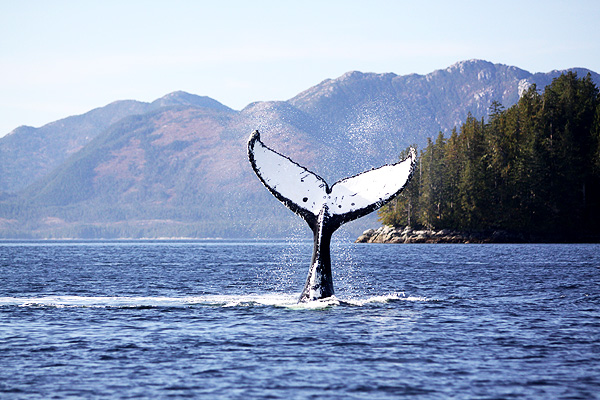Finding Yoda – Part 4
In 2002, Cetacea Lab’s Janie Wray and Hermann Meuter first encountered a very special humpback named Yoda. He’s returned to Caamano Sound every summer since. For over a decade, Cetacea Lab has recorded more and more humpbacks, like Yoda, returning to feed and sing their mysterious songs here. That’s why WWF is working hard with Cetacea Lab to protect this vital habitat. Food from B.C.’s north coast will sustain the whales long after they’ve departed for winter homes in Hawaii, Mexico or Japan. So where does Yoda spend his winter? Janie does some whale detective work and makes a surprising discovery along the way.
Written by Janie Wray, Director of Cetacea Lab
Every August, when Yoda makes his first rambunctious entrance to Whale Channel, I ask myself, “Where has this whale been all season?” The fact that Yoda arrives close to the same date each year tells me he’s on a schedule; his regular appearance on B.C.’s north coast is not some random event. Yoda will stay for the next month and has a definite reason for showing up when he does.

Rambunctious Yoda always makes a splash. © Forwhales.org
- Humpbacks spend part of every summer and fall filling up on food from these nutrient-rich waters. Late in November, many will head for warmer waters across the Pacific to mate and have their young. We believe Yoda shows up here to participate in social behaviours important to humpback culture – singing or mating rituals inquiet ocean waters. But where does Yoda go in the winter? And what can we learn from that?
Finding a whale in the Pacific Ocean – even one as distinctive as Yoda – is not an easy task. I began my search for his winter home by looking through catalogues of humpback whales documented in Hawaii, Mexico and Japan. Scientists identify humpbacks from ID photographs of their massive patterned tails called ‘flukes’. No whale tail is alike and, as you can tell from the photo below, Yoda’s all-white fluke is hard to miss. I searched through catalogues of photos hoping to spot this fluke – but no luck.

Yoda’s unique almost all-white fluke markings make him easy to spot. © Forwhales.org
More than a thousand photos later, I thought there must be an easier way. I seek help from a colleague I’d worked with at the SPLASH project in 2004. This was a three-year, international, cooperative effort by researchers to understand the population structure of humpback whales across the North Pacific. Every whale was given an ID according to the color of his or her tail: “X” whales have black flukes,“Y” whales have black-and-white flukes, and “Z” whales have white ones.
Searching the SPLASH database, I soon realized, would also take forever; there were thousands of whales to sort through! As my frustration reached a peak, my colleague sent good news – a website address where I could key in Yoda’s B.C. ID number and get a corresponding one for Hawaii or Alaska. I entered BCZ0136… and there was Yoda. He’d been spotted in Hawaii during the winter and Alaska in early summer.
But that’s not all. I was shocked to see the Hawaii database listed Yoda as a female! I’ve never been completely sure of the sex of this majestic whale but usually refer to Yoda as a male, after observing his behaviour for 12 years. Mistakes have been made on databases before, so unless Yoda shows up one year with a calf, I will tend to still identify him as a male. It’s not possible to identify the sex of a humpback from the surface without seeing its underbelly. And without a DNA sample or a calf by its side, we can’t tell for sure. But this discovery has added a new mystery to Yoda. I want to find out more!
Armed with Yoda’s Hawaiian ID number, I’m able to have a great conversation with my colleague at SPLASH that leads to some real information. Yes, Yoda does spend winters in Hawaii. He’s also been spotted in Alaska where he feeds for the first part of the summer. He heads our way in late August, stays well into October then returns to Alaska for another month before a long migration south across the Pacific to Hawaii.

Yoda’s vigorous acrobatics stir up the other humpbacks when he arrives. © Forwhales.org
It’s June – so we now know that Yoda will have likely passed our coastline, swimming north to Alaska. By late August, we’ll await his usual return – a vigorous display of acrobatics that stirs up the other humpbacks. We don’t know for sure why this area is so important to Yoda. But he’s back each year in time for the most spectacular social event of the season – the singing of male humpbacks in the deep fjords surrounding Whale Point.
These are some of the quietest ocean waters on B.C.’s coast, relatively free from man-made underwater noise and ideal for whale communication. One thing we do know, Yoda and other whales from across the Pacific depend on a quiet ocean home!
Learn more about Cetacea Lab’s work.
Learn more about WWF’s work on B.C.’s north coast.
Help protect the Great Bear Sea for now, and forever. Visit Greatbearsea.org and add your name.


